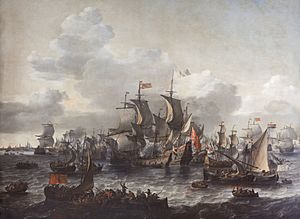Battle on the Zuiderzee facts for kids
Quick facts for kids Battle on the Zuiderzee |
|||||||
|---|---|---|---|---|---|---|---|
| Part of the Eighty Years' War | |||||||
 The battle, painted by Jan Theunisz. Blanckerhoff. |
|||||||
|
|||||||
| Belligerents | |||||||
| Commanders and leaders | |||||||
| Count of Boussu (POW) | |||||||
| Strength | |||||||
| 24 ships 700 sailors |
30 ships 1300 sailors |
||||||
| Casualties and losses | |||||||
| 1 ship lost 25 sailors lost |
6 ships captured 300 sailors captured |
||||||
The Battle on the Zuiderzee was an important naval battle that happened on October 11, 1573. It was part of the Eighty Years' War, a long fight where the Dutch people tried to gain independence from Spain. In this battle, a smaller Dutch fleet managed to defeat a larger and stronger Spanish fleet on the Zuiderzee, which is now called the IJsselmeer.
Contents
Why the Battle Happened
Before this battle, the big Dutch city of Amsterdam was still loyal to the king of Spain. Most of the supplies for both Spanish and Dutch areas traveled through the Zuiderzee. The Dutch rebels, who called themselves de Geuzen, tried to stop these supplies as much as they could. They did this by attacking Spanish ports and ships.
In 1573, the Spanish Governor, Maximilian de Henin Count of Bossu, decided to stop these attacks. He sent a fleet of about 30 ships with over 1,300 sailors. His main ship was called the Inquisition. It was very big, weighing over 250 tons, and had strong armored sides. To fight against this powerful Spanish fleet, the Geuzen put together a small fleet of 24 much smaller and lighter ships. They had about 700 men in total.
The Battle Begins
Count Bossu and his fleet left Amsterdam on October 5. Right away, they faced problems. The Geuzen ships kept attacking them. Because the Dutch ships didn't have heavy guns, they couldn't fight the Spanish ships head-on. Instead, they planned to try and board the Spanish ships. If they could, they would capture them. If not, they would try to destroy them.
The Dutch tried to get close to the Spanish ships to board them, hoping to avoid the powerful Spanish cannons. But strong winds made it very hard for the Dutch ships to get near. This stopped their boarding plan. With their main attack method blocked, the Dutch fleet suffered heavy losses from the Spanish guns.
A Change in Wind and Fortune
The battle changed on October 11. The wind direction shifted, which helped the Dutch. They were able to launch a surprise attack. During this attack, the Dutch managed to board the Spanish flagship, the Inquisition. In the fight, the Inquisition got stuck on the shallow seabed.
The rest of the Spanish fleet quickly sailed away. Count Bossu and his crew had to give up after the Dutch promised not to harm them.
What Happened Next
After losing this battle and failing to capture the city of Alkmaar, Duke of Alva, a Spanish leader, realized he couldn't win in North Holland. He decided to leave Amsterdam and went back to Spain. This battle was a big victory for the Dutch rebels in their fight for independence.
See also
 In Spanish: Batalla del Zuiderzee para niños
In Spanish: Batalla del Zuiderzee para niños

